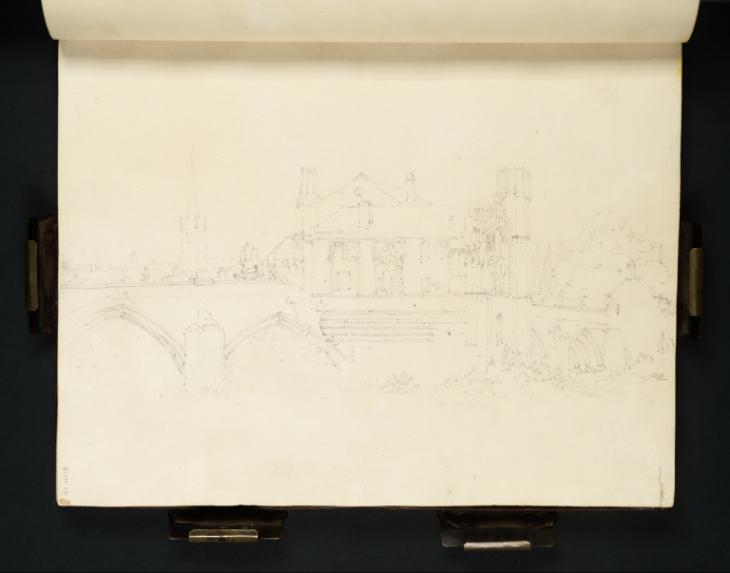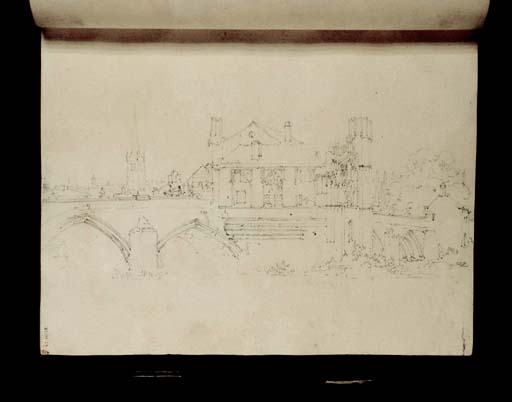Joseph Mallord William Turner Wakefield Bridge 1797
Image 1 of 2
Joseph Mallord William Turner,
Wakefield Bridge
1797
Joseph Mallord William Turner 1775–1851
Folio 10 Recto:
Wakefield Bridge 1797
D00915
Turner Bequest XXXIV 10
Turner Bequest XXXIV 10
Pencil on white wove paper, 210 x 270 mm
Blind-stamped with Turner Bequest monogram bottom centre
Stamped in black ‘XXXIV 10’ bottom left, descending vertically
Blind-stamped with Turner Bequest monogram bottom centre
Stamped in black ‘XXXIV 10’ bottom left, descending vertically
Accepted by the nation as part of the Turner Bequest 1856
References
1909
A.J. Finberg, A Complete Inventory of the Drawings of the Turner Bequest, London 1909, vol.I, p.70, XXXIV 10, as ‘The Chantry, Wakefield. On back is written “G. D.” (An engraving of Wakefield from a drawing by Turner was published in “Copperplate Magazine” for June, 1798. This shows more of both banks of river, but the view of the Chantry is somewhat similar to this drawing,’.
1924
Herbert E. Wroot, ‘Turner in Yorkshire, His Wanderings and Sketches’, Thoresby Society Miscellanea, Vol. XXVI, 1924, p.227.
1996
David Hill, Turner in the North: A Tour through Derbyshire, Yorkshire, Durham, Northumberland, the Scottish Borders, the Lake District, Lancashire and Lincolnshire in the Year 1797, New Haven and London 1996, pp.20, 190.
The Chantry Chapel of St Mary on the bridge over the River Calder at Wakefield, built in 1342, was a popular subject with antiquarian topographers. Turner made another study of the bridge in his Tweed and Lakes sketchbook (Tate D01004; Turner Bequest XXXV 1a). A larger pencil study of this subject is Tate D01095 (Turner Bequest XXXVI A), and a finished watercolour is in the British Museum, London.1 He made a small view of Wakefield (currently untraced),2 though not apparently relying on this drawing, for the Copper Plate Magazine, June 1798 (Tate impression: T05903). David Hill suggests that this was executed some years prior to the 1797 tour, presumably from a drawing by another artist; the general composition of the Copper Plate subject would support an earlier dating. The tall spire in the left background is that of the Parish Church of All Saints, at 247 feet (75 metres) the highest in Yorkshire. The church became a cathedral in 1888.
The subject is drawn with the page turned horizontally.
Verso:
Blank; inscribed by Turner in pencil ‘GD’; stamped in brown ink with Turner Bequest monogram. The initials may refer to a patron who had asked for a watercolour of the subject of Wakefield Bridge, drawn on the recto; or the inscription may apply to the drawing on folio 11 recto opposite (D00916; Turner Bequest XXXIV 10a, removed for display by John Ruskin and not certainly from this position in the book, though it is likely to be correct).
Andrew Wilton
January 2013
How to cite
Andrew Wilton, ‘Wakefield Bridge 1797 by Joseph Mallord William Turner’, catalogue entry, January 2013, in David Blayney Brown (ed.), J.M.W. Turner: Sketchbooks, Drawings and Watercolours, Tate Research Publication, November 2014, https://www


